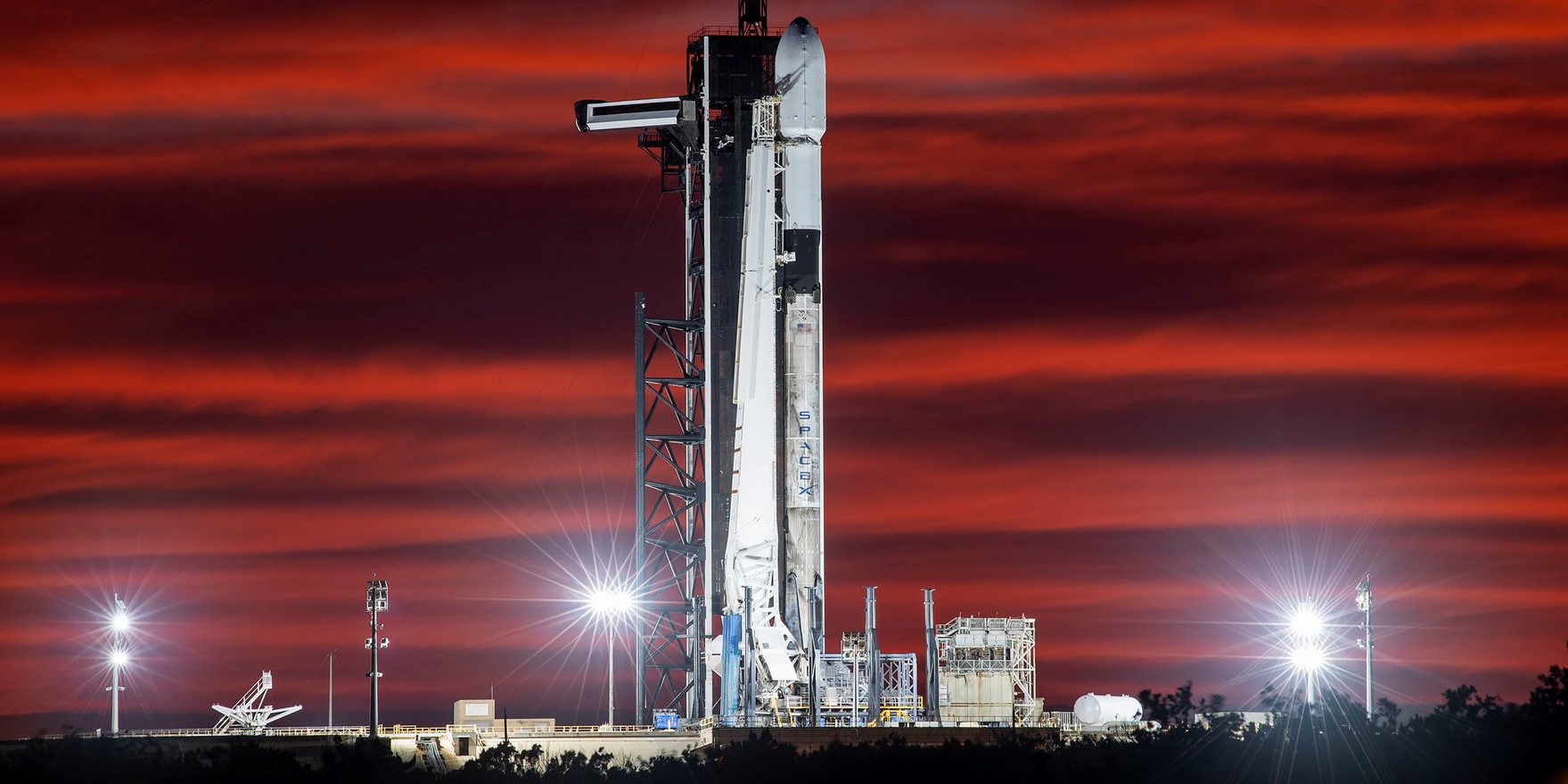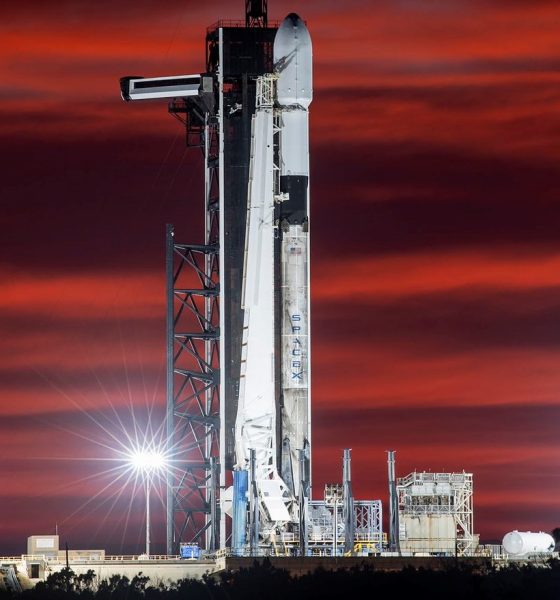

News
SpaceX Falcon 9 rocket goes vertical for 44th Starlink launch
A SpaceX Falcon 9 rocket has gone vertical at Kennedy Space Center Pad 39A ahead of the company’s 18th launch this year and 44th dedicated Starlink launch overall.
Known as Starlink 4-17, the mission will kick off up to four Starlink launches planned for May 2022. SpaceX has chosen Falcon 9 booster B1058 to launch the mission’s expendable upper stage, reusable fairing, and 53 Starlink V1.5 satellites into space, potentially making it the third Falcon booster to complete its 12th orbital-class launch in the last two months.
Barring delays, Falcon 9 will lift off with Starlink 4-17 as early as 5:42 am EDT on Friday, May 6th.
The mission is about as standard as Starlink launches come. Falcon 9 B1058 will lift off and burn for two and a half minutes before separating, flipping around, reentering Earth’s atmosphere, and landing around 634 kilometers (393 mi) downrange on drone ship A Shortfall Of Gravitas (ASOG) six minutes later. The payload fairing will split into halves and separate shortly after booster separation and eventually deploy parachutes for soft ocean landings and recovery. Falcon 9’s upper stage will reach a parking orbit about nine minutes after liftoff, reignite for just a second 45 minutes after liftoff, and deploy all 53 Starlink satellites 53 minutes after liftoff.
Starlink 4-17 will be SpaceX’s 43rd operational Starlink launch and 44th dedicated Starlink launch overall. The mission will raise the total number of Starlink satellites launched by SpaceX in the last three years to just shy of 2500 and the total number of working Starlink satellites in orbit above 2200. When SpaceX received its initial Starlink FCC license in March 2018, the company agreed to a deployment schedule that required half of the then 4425 satellites to be launched within six years and the full constellation within nine years of license receipt – March 2024 and March 2027, respectively.
SpaceX has far exceeded the pace required to meet that schedule. Instead, despite the fact that it took SpaceX 20 months after receiving its license to begin operational Starlink launches in November 2019, SpaceX will cross the halfway point on May 6th, 2022 – nearly two years faster than required. In fact, even without considering Starship’s potential impact, SpaceX’s growing launch cadence suggests that the company could finish its first 4408-satellite Starlink constellation by the FCC’s 50% deadline.
Finally, after Starlink 4-17, SpaceX should also have more than 700 working Starlink V1.5 satellites in orbit since launches began in September 2021. While hundreds of those satellites are still in transit to their final orbits, almost a third of all operational Starlink satellites will have optical inter-satellite links (laser links) once the Starlink V1.5 spacecraft already in orbit finish orbit-raising. Those laser links allow Starlink to connect aircraft, ships, and other moving or exceptionally remote vehicles or locations by routing communications through other Starlink satellites when no line-of-sight ground station is available.

News
Tesla FSD fleet is nearing 7 billion total miles, including 2.5 billion city miles
As can be seen on Tesla’s official FSD webpage, vehicles equipped with the system have now navigated over 6.99 billion miles.

Tesla’s Full Self-Driving (Supervised) fleet is closing in on almost 7 billion total miles driven, as per data posted by the company on its official FSD webpage.
These figures hint at the massive scale of data fueling Tesla’s rapid FSD improvements, which have been quite notable as of late.
FSD mileage milestones
As can be seen on Tesla’s official FSD webpage, vehicles equipped with the system have now navigated over 6.99 billion miles. Tesla owner and avid FSD tester Whole Mars Catalog also shared a screenshot indicating that from the nearly 7 billion miles traveled by the FSD fleet, more than 2.5 billion miles were driven inside cities.
City miles are particularly valuable for complex urban scenarios like unprotected turns, pedestrian interactions, and traffic lights. This is also the difference-maker for FSD, as only complex solutions, such as Waymo’s self-driving taxis, operate similarly on inner-city streets. And even then, incidents such as the San Francisco blackouts have proven challenging for sensor-rich vehicles like Waymos.
Tesla’s data edge
Tesla has a number of advantages in the autonomous vehicle sector, one of which is the size of its fleet and the number of vehicles training FSD on real-world roads. Tesla’s nearly 7 billion FSD miles then allow the company to roll out updates that make its vehicles behave like they are being driven by experienced drivers, even if they are operating on their own.
So notable are Tesla’s improvements to FSD that NVIDIA Director of Robotics Jim Fan, after experiencing FSD v14, noted that the system is the first AI that passes what he described as a “Physical Turing Test.”
“Despite knowing exactly how robot learning works, I still find it magical watching the steering wheel turn by itself. First it feels surreal, next it becomes routine. Then, like the smartphone, taking it away actively hurts. This is how humanity gets rewired and glued to god-like technologies,” Fan wrote in a post on X.
News
Tesla starts showing how FSD will change lives in Europe
Local officials tested the system on narrow country roads and were impressed by FSD’s smooth, human-like driving, with some calling the service a game-changer for everyday life in areas that are far from urban centers.

Tesla has launched Europe’s first public shuttle service using Full Self-Driving (Supervised) in the rural Eifelkreis Bitburg-Prüm region of Germany, demonstrating how the technology can restore independence and mobility for people who struggle with limited transport options.
Local officials tested the system on narrow country roads and were impressed by FSD’s smooth, human-like driving, with some calling the service a game-changer for everyday life in areas that are far from urban centers.
Officials see real impact on rural residents
Arzfeld Mayor Johannes Kuhl and District Administrator Andreas Kruppert personally tested the Tesla shuttle service. This allowed them to see just how well FSD navigated winding lanes and rural roads confidently. Kruppert said, “Autonomous driving sounds like science fiction to many, but we simply see here that it works totally well in rural regions too.” Kuhl, for his part, also noted that FSD “feels like a very experienced driver.”
The pilot complements the area’s “Citizen Bus” program, which provides on-demand rides for elderly residents who can no longer drive themselves. Tesla Europe shared a video of a demonstration of the service, highlighting how FSD gives people their freedom back, even in places where public transport is not as prevalent.
What the Ministry for Economic Affairs and Transport says
Rhineland-Palatinate’s Minister Daniela Schmitt supported the project, praising the collaboration that made this “first of its kind in Europe” possible. As per the ministry, the rural rollout for the service shows FSD’s potential beyond major cities, and it delivers tangible benefits like grocery runs, doctor visits, and social connections for isolated residents.
“Reliable and flexible mobility is especially vital in rural areas. With the launch of a shuttle service using self-driving vehicles (FSD supervised) by Tesla in the Eifelkreis Bitburg-Prüm, an innovative pilot project is now getting underway that complements local community bus services. It is the first project of its kind in Europe.
“The result is a real gain for rural mobility: greater accessibility, more flexibility and tangible benefits for everyday life. A strong signal for innovation, cooperation and future-oriented mobility beyond urban centers,” the ministry wrote in a LinkedIn post.
News
Tesla China quietly posts Robotaxi-related job listing
Tesla China is currently seeking a Low Voltage Electrical Engineer to work on circuit board design for the company’s autonomous vehicles.

Tesla has posted a new job listing in Shanghai explicitly tied to its Robotaxi program, fueling speculation that the company is preparing to launch its dedicated autonomous ride-hailing service in China.
As noted in the listing, Tesla China is currently seeking a Low Voltage Electrical Engineer to work on circuit board design for the company’s autonomous vehicles.
Robotaxi-specific role
The listing, which was shared on social media platform X by industry watcher @tslaming, suggested that Tesla China is looking to fill the role urgently. The job listing itself specifically mentions that the person hired for the role will be working on the Low Voltage Hardware team, which would design the circuit boards that would serve as the nervous system of the Robotaxi.
Key tasks for the role, as indicated in the job listing, include collaboration with PCB layout, firmware, mechanical, program management, and validation teams, among other responsibilities. The role is based in Shanghai.
China Robotaxi launch
China represents a massive potential market for robotaxis, with its dense urban centers and supportive policies in select cities. Tesla has limited permission to roll out FSD in the country, though despite this, its vehicles have been hailed as among the best in the market when it comes to autonomous features. So far, at least, it appears that China supports Tesla’s FSD and Robotaxi rollout.
This was hinted at in November, when Tesla brought the Cybercab to the 8th China International Import Expo (CIIE) in Shanghai, marking the first time that the autonomous two-seater was brought to the Asia-Pacific region. The vehicle, despite not having a release date in China, received a significant amount of interest among the event’s attendees.








